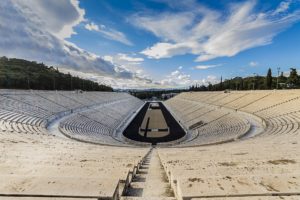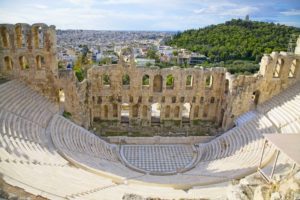The Museum of Cycladic Art is one of the great museums of Athens, housing a remarkable collection of artifacts from the Cycladic civilization that flourished during early antiquity.
It all began in the 1960s when Nicholas and Dolly Goulandris began to collect ancient artifacts and Cycladic figurines. As time went on, the collection increased in size and traveled to famous museums all over the world. The Museum of Cycladic Art opened its doors to the public in January 1986.
One of the Museum wings that hosts temporary exhibitions is the Stathatos Mansion (1 Irodotou & Vas. Sofias Ave), one of the best examples of neoclassical architecture in Athens, work of the Bavarian architect Ernest Ziller.
The permanent collections housed by the Museum of Cycladic Art are:
Cycladic Art
The Cycladic civilization flourished on the islands of the central Aegean during the Early Bronze Age (3rd millennium BC). The MCA maintains one of the largest and most complete collections of Cycladic Antiquities in the world. It consists of representative samples of marble figurines and vases, bronze weapons and tools and pottery of all phases of the Early Cycladic period.
The collection Cycladic is set on the first floor of the building of the permanent collections and opened in 1986. It includes a large number of high-quality marble figurines and vases, some of the earliest bronze objects in the Aegean pottery everyday and ritual use, etc. most of which belong in the 3rd millennium BC. It also includes:
- highly sculptured marble bottles, plates, cups, and zoomorphic vessels
- marble standards
- metal objects, such as bronze tools and weapons, leaden figurines and a small silver vessel,
- symbolic objects such as frying vessels, which are decorated with incised motifs reminiscent of the sea, the stars and female fertility
- the so-called “Treasure of Keros“
One of the most valuable objects is a female figurine of the Early Cycladic II period, with a height of 1.40 meters. It is the second largest in the world and known as “Vase Pigeon,“ also held prominently in the report, it is the biggest and most complete example that has been found up to date.
Ancient Greek Art
The birth of Greek art in the protohistoric Aegean, the development of Classical culture and its gradual dissemination all over the Mediterranean basin constitute one of the most influential phenomena in the history of western civilization.
The MCA holds an enormous collection of Ancient Greek Art with representative artifacts from all periods between the Middle Bronze Age (2nd millennium BC) to the very end of the Roman period (4th c. AD).
You can find the collection on the 2nd and 4th floor of the Main Building under the titles “A History in Images” and “Scenes from Daily Life in Antiquity.”
The permanent exhibition on the 4th floor of the Main Building tries to transform knowledge about daily life in antiquity (as provided by ancient texts and archaeological objects) into vivid images.
Visitors can have a virtual tour of time and space. The tour starts from the world of the supernatural (gods) and the myth (heroes). Then, goes into the realm of Eros, follows the activities of everyday women and men in their private and public life, explores their religious behavior, and concludes with their attitudes against death and their beliefs about the afterlife and the Underworld.
142 objects – mostly dating to the Classical and Hellenistic periods (5th-1st c. BC) – are grouped in nine separate units treating the following thematic areas:
- Gods and Heroes
- On the wings of Eros
- Toiletry and wedding
- Female activities
- Athletics
- The Symposium
- In the Athenian Agora
- Warfare
- Taking care of the deceased
The exhibition is supported by ample graphics which are meant both to increase the overall aesthetic effect and to enhance public understanding of the various artifacts and their function.
Each showcase has a frieze of drawings accompanied by explanatory texts which provide as much information as possible about the particular subject. To increase the educational character of the exhibition, two short movies, have been made, using advanced shooting and sound-recording techniques.
The tour concludes with a hypothetic painted reconstruction of an ancient 5th c. BC town (demos) on the coast of Attica, where the hero was born, lived and died, according to the scenario of the films.
Cypriot Art
The Collection of Cypriot Antiquities, one of world’s most famous, was added to the permanent collections of the Museum of Cycladic Art in 2002 on a long-term loan and presented to the public for the first time in 2004. Completed in 2012 and based on a new museographical study, the display showcases 550 (previously 400) objects dating from the Chalcolithic to the Byzantine, Medieval, and Modern periods, grouped according to time and category.
The new display uses modern museological approach (in design, color, lighting, and presentation of the exhibits on relevantly illustrated surfaces). It highlights the rich in style, decoration, and imaginative shapes Cypriot pottery (utilitarian, storage, and table wares) of the prehistoric and historic periods, which represent the collection’s core.
The pottery is presented in ten cases, covering a wide spectrum from the mid-3rd Millennium BC to Late Antiquity.
Separate cases corresponding to different thematic units complete the pottery display: religion, weaving, perfume making, funerary rites, writing, metalworking, coins, seal stones, and foreign relations. The external display also includes glass vases and jewelry presented by chronology and category. The development of the human form in figurines and sculpture from Chalcolithic to Roman times is shown in prominent cases in the center of the gallery. Visitors can understand specific types in the long development from the first Chalcolithic figurines and pendants of the fourth millennium BC, made of native Cypriot picrolite, to the acme of terracotta and sculptural art in limestone – and, rarely, marble – of the Iron Age.
Texts, maps and a chronological chart gives information about the exhibits. There are also multimedia applications on touch screens with texts, figures, and drawings that contain further information on Cypriot Copper, the commodity that brought wealth and well-being to the island, the history of writing and coinage.


